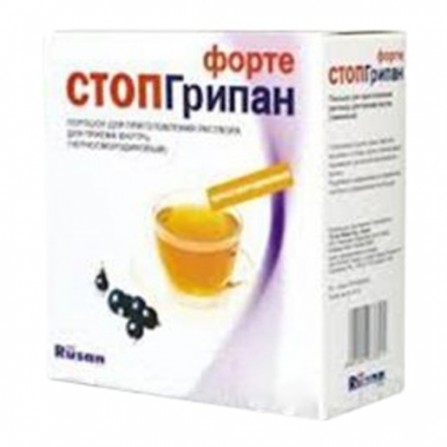Stopgripan powder for black currant N10
Condition: New product
1000 Items
Rating:
Be the first to write a review!

More info
Active ingredients
Paracetamol + Phenylephrine + Pheniramine + Ascorbic Acid
Composition
1 sachet paracetamol 325 mg phenylephrine hydrochloride 10 mg pheniramine maleate 20 mg ascorbic acid 50 mg. Excipients: calcium phosphate, citric acid, maltodextrin, sodium citrate dihydrate, sucrose, titanium dioxide, ethyl maltol, malic acid, blackcurrant flavor, brilliant blue dye, dye yellow sunset, Ponso 4R dye.
Pharmacological effect
Combined drug. Paracetamol has antipyretic and analgesic effects. Phenylephrine - vasoconstrictor action, thereby eliminating the swelling of the mucous membranes of the nose, nasopharynx and paranasal sinuses, reducing nasal discharge, thereby facilitating nasal breathing. Pheniramine has anti-allergic and anti-edema action, reduces vascular permeability, nasal discharge, tearing, eliminates sneezing. Ascorbic acid is involved in the regulation of redox processes, carbohydrate metabolism, blood clotting, tissue regeneration, in the synthesis of steroid hormones; increases the body's resistance to infections, reduces vascular permeability, reduces the need for vitamins B1, B2, A, E, folic acid, pantothenic acid. It improves the tolerance of paracetamol and prolongs its action.
Indications
- colds, flu, acute rhinitis, rhinopharyngitis, sinusitis, inflammation of the paranasal sinuses, accompanied by fever, chills, runny nose, nasal congestion, headache - pain syndrome (mild and moderate): arthralgia, myalgia, neuralgia, migraine, toothache and headache, pain in injuries, algomenorrhea.
Contraindications
- hypersensitivity to paracetamol and other components of the drug - taking other drugs containing substances that are part of Stopgripan - simultaneous taking of tricyclic antidepressants, MAO inhibitors, beta-blockers - portal hypertension - alcoholism - diabetes - pregnancy, - period lactation - children's age up to 12 years.With caution in atherosclerosis .
Use during pregnancy and lactation
Contraindicated - during pregnancy and lactation.
Dosage and administration
The contents of 1 sachet (bag) pour in a glass, pour hot water, mix until dissolved and drink. Adults and children over 12 years old should take 1 sachet 3-4 times / day with intervals between doses of 6 hours (no more than 4 sachets per day). Consult a doctor if symptoms persist within 5 days.
Side effects
In therapeutic doses, the drug is usually well tolerated, but there may be an increase in blood pressure, allergic reactions (skin itch, rash, urticaria, angioedema), dry mouth, nausea, vomiting, pain in the epigastric region, decreased speed of psychomotor reactions, increased excitability, dizziness , heartbeat, sleep disturbance, urinary retention, renal colic, glycosuria, mydriasis, accommodation paresis, increased intraocular pressure. Given the presence of paracetamol in the composition of the drug, violations of the hematopoietic system (thrombocytopenia, leukopenia, agranulocytosis, hemolytic anemia, aplastic anemia) can be rarely observed; with long-term administration in high doses, disorders of the liver and kidney function are possible (hepatotoxic effect, nephrotoxicity - papillary necrosis).
Overdose
It is caused, as a rule, by paracetamol. Possible: pallor of the skin, anorexia, nausea, vomiting, pain in the epigastric region; in severe cases, liver failure, hepatonecrosis, increased activity of hepatic transaminases, an increase in prothrombin time, encephalopathy, and a coma. A detailed clinical picture of liver damage occurs after 1-6 days. Rarely, liver failure develops with lightning speed and may be complicated by renal failure (tubular necrosis).Treatment: gastric lavage followed by the appointment of activated carbon; symptomatic therapy; the introduction of SH-grypp donators and precursors of the synthesis of glutathione - methionine 8-9 hours after an overdose, and N-acetylcysteine - 12 hours later
Interaction with other drugs
Enhances the effects of MAO inhibitors, sedatives, ethanol. Antidepressants, anti-parkinsonian drugs, antipsychotics, phenothiazine derivatives increase the risk of urinary retention, dry mouth, and constipation. Glucocorticosteroids increase the risk of developing an increase in intraocular pressure. Paracetamol reduces the effectiveness of uricosuric drugs and increases the effectiveness of indirect anticoagulants. Pheniramine at the same time as MAO inhibitors, furazolidone can cause hypertensive crisis, agitation, hyperpyrexia. Tricyclic antidepressants increase the sympathomimetic effect, the simultaneous appointment of halothane increases the risk of ventricular arrhythmias. Reduces the hypotensive effect of guanethidine, which, in turn, enhances the alpha-adrenostimuliruyuschy activity of phenylephrine. With the simultaneous appointment of Stopgripan with barbiturates, difenin, carbamazepine, rifampicin and other inducers of liver microsomal enzymes, the risk of the development of the hepatotoxic effect of paracetamol increases.
special instructions
In order to avoid toxic damage to the liver, the drug should not be combined with the use of alcoholic beverages. If, despite taking Stopgripan, the disease is accompanied by continuing fever or there are repeated fever, consult a doctor. Influence on the ability to drive motor vehicles and control mechanisms Patients taking Stoptripan should refrain from activities that require increased attention and speed of mental and motor responses, including and driving a car.





